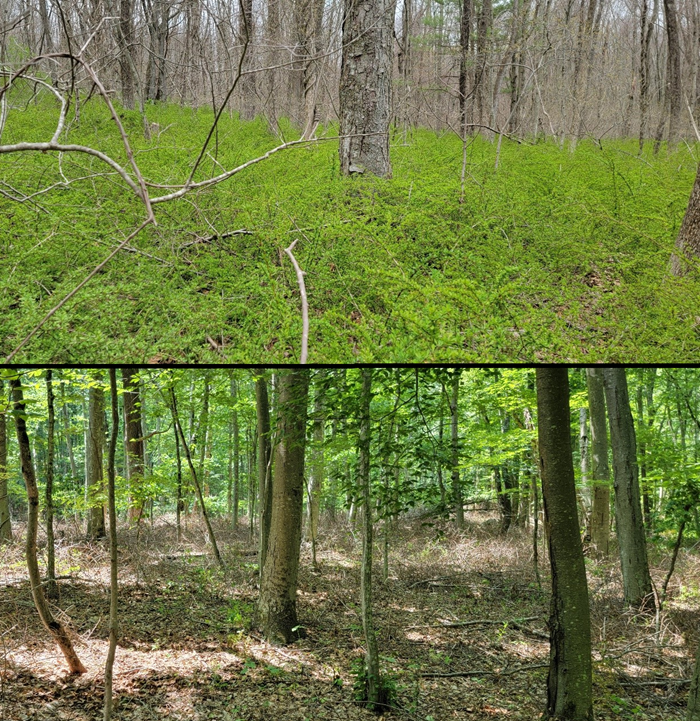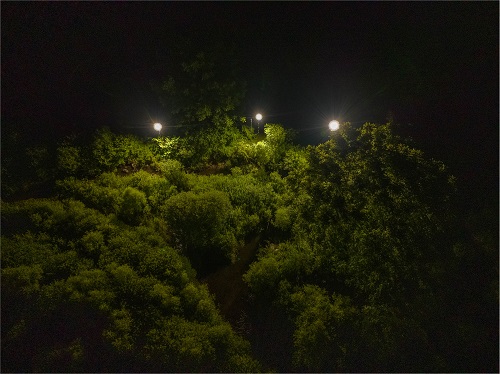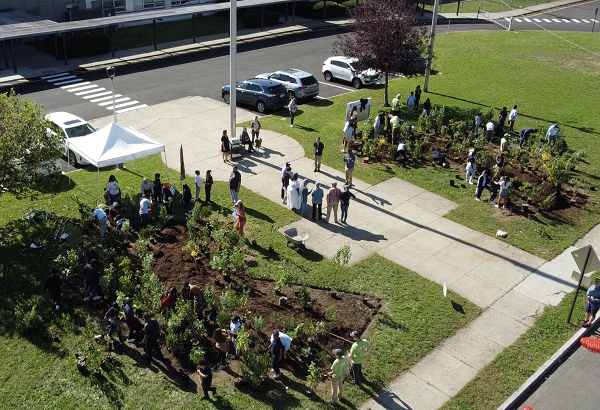Stories from our Conservation Partners
Connecticut's Wildlife Action Plan identifies the many species in need of protection, the habitats they rely on, the issues they face, and the actions we can take to conserve wildlife populations into the future. Conservation happens through a network of organizations and individuals working together. Here, we highlight some of the incredible conservation work being accomplished by our partners! These stories are also featured in our quarterly Wildlife Action Plan newsletter. To subscribe, please select this link.
Stories on this page:
- Miyawaki Forests | Aspetuck Land Trust
- Bats and Light Pollution | Great Hollow Nature Preserve and Ecological Research Center
- Tree Planting for Egrets and Ibises | Charles Island Reforestation LLC
- New Checklist of Connecticut's Bees | Connecticut Agricultural Experiment Station
- Conservation Engagement from Municipalities | CACIWC and Andover Conservation Commission
- Protecting Habitat and Rare Plants | Norcross Wildlife Foundation
Learn more about Connecticut's Wildlife Action Plan.
Protecting Habitat and Rare Plants | Norcross Wildlife Foundation

Norcross Wildlife Foundation stewards over 8,000 acres in south-central Massachusetts and north central Connecticut with the mission of preserving and managing ecologically significant habitats that sustain and enhance biodiversity and wildlife populations in our region. With 8,000 acres comes plenty of challenges, including invasive species. Norcross has been using Connecticut's Wildlife Action Plan to identify key habitats and prioritize invasive species management in these areas. In Connecticut, this predominantly means managing invasive plant species in the richer expressions of the Northern Hardwood Forests. These sites are often home to unique plant species such as ramps (Allium tricoccum), Trilliums (Trillium spp.), and orchids, such as Large Whorled Pogonia (Isotria verticillata) and bog orchids (Platanthera spp.). Unfortunately, with the richer soils often comes invasive species, especially Japanese Barberry (Berberis thunbergii). A systematic assessment of uncommon habitats and invasive species began in 2022, and Norcross is actively prioritizing invasive species management where the two meet.
Two abutting parcels in Stafford were recently identified as priority sites for Norcross Wildlife Foundation. The parcels are dominated by Sugar Maple (Acer saccharum) with scattered Black Cherry (Prunus serotina), White Ash (Fraxinus americana), and American Basswood (Tilia americana) and represent a richer and more mesic forest than what is typical of the region. The understory is diverse, including species such as the aforementioned ramps, trillium, and native orchids in addition to Ostrich Fern (Matteuccia struthiopteris), Poke Milkweed (Asclepias exaltata), Horsebalm (Collinsonia canadensis), White Baneberry (Actaea pachypoda) and other herbaceous species uncommon enough to be of note. As expected, invasive plants, including Japanese Barberry, Multiflora Rose (Rosa multiflora), and Asiatic Bittersweet (Celastrus orbiculatus) were also quite common in the forest understory. Though work has not yet begun on the management of these species, these parcels are on the short-list for future management.
The invasive plant species being targeted by Norcross have spread widely since being introduced from overseas. Invasives outcompete native plants, taking away space, soil nutrients, and sunlight. This also impacts populations of native herbivorous insects who, for the most part, do not eat invasive plants. Invasive plants contain chemicals that are unpalatable and indigestible for our insects, who prefer the native vegetation they have coevolved with. As many birds, mammals, reptiles, and amphibians on our list of Species of Greatest Conservation Need rely heavily on insects for food, areas overrun with invasive plants also provide less support for these species.
White Ash and Large Whorled Pagonia, mentioned above, are both listed as State Assessment Priority Species in Connecticut’s 2025 Wildlife Action Plan, meaning that more information is needed to assess their status and population trends in our state. Natural resource inventories are a way that organizations can help us all learn more about the distribution and abundance of these species.
Photo of ramps (Allium tricoccum), above, courtesy of Norcross Wildlife Foundation.
Story from October 2025.
Conservation Engagement from Municipalities | CACIWC and Andover Conservation Commission
The Connecticut Association of Conservation and Inland Wetlands Commissions, Inc. (CACIWC) works to promote awareness among land use commissions of the ongoing efforts by the CT Department of Energy and Environmental Protection (DEEP) on their 2025 revision of Connecticut's State Wildlife Action Plan. Using its publication The Habitat and its annual conference, CACIWC encourages all Connecticut conservation commissions to be more active in efforts to protect Species of Greatest Conservation Need (SGCN) within their municipality and region.

One example of an extremely active commission working to protect SGCN populations is the Andover Conservation Commission. Over the past five years, the Commission has undertaken several initiatives to engage municipal officials and landowners in conserving wildlife and habitats. These efforts have included: (1) addressing declines in pollinating insects by establishing an official monarch butterfly waystation and pollinator garden, presenting workshops for landowners on creating pollinator-friendly habitat, and working with the Town Administrator and Public Works Department to implement best mowing practices to enhance habitat for pollinating insects of conservation need, including various species of declining bumblebees on town-owned properties; (2) enhancing privately-owned forest habitats that support a wide variety of imperiled wildlife, including songbirds (e.g., veery, wood thrush, scarlet tanager, rose-breasted grosbeak), raptors (e.g., broad-winged hawk), tree-roosting bats (e.g., eastern red bat, hoary bat), by presenting workshops and recruiting landowners of forested properties to participate in various Natural Resource Conservation Service (NRCS) programs such as the Environmental Quality Incentives (EQUIP), Conservation Stewardship (CSP), and Working Lands for Wildlife programs; and (3) engaging with the Inland Wetlands and Watercourses Commission, landowners, and the University of Connecticut’s Climate Corps Municipal Assistance Program to map and collect biological data on vernal pools to inform site reviews and land use planning. Vernal pools provide critical breeding habitat for amphibians of conservation need, including the wood frog, spotted salamander, and marbled salamander.
These efforts have all been informed by a natural resource inventory (NRI) and mapping project that the Commission completed in preparation for the 2025 revision of the town’s Plan of Conservation and Development. In addition to continuing work on the above projects, the Commission is planning future initiatives to implement conservation actions based on the results of the NRI. These initiatives include working with the agricultural community to reduce injury and mortality of individual wood turtles during haying operations by promoting best mowing practices. In addition to being listed as Special Concern in Connecticut, the wood turtle is under review by the U.S. Fish and Wildlife Service for potential listing under the Endangered Species Act. The Commission also promotes best forest management practices around vernal pools and wetlands among landowners to minimize impacts to populations of vernal pool-dependent amphibians during timber harvests. Finally, the Commission has submitted recommendations to the Planning and Zoning Commission for updating various wetland and zoning regulations and policies to enhance protection of important wetland, watercourse, and forest habitat. One such recommendation suggests increasing upland review areas around vernal pools and cold-water streams. Cold-water streams are increasingly vulnerable to impacts associated with climate change, and they are critical habitat for various Species of Greatest Conservation Need, including brook trout and the northern dusky salamander.

Private forested land adjacent to Bishop Swamp Wildlife Management Area in Andover, CT. Photos depict the same land before (upper) and after (lower) the removal of invasive Japanese barberry, a prevalent nonnative shrub. Photos courtesy of Andover Conservation Commission / Hank Gruner.
Story from July 2025.
New Checklist of Connecticut's Bees | Connecticut Agricultural Experiment Station

Through their role as pollinators, bees support ecosystems in Connecticut and across the world. From forests and native meadows to agricultural fields, these ecosystems also sustain people and keep our planet habitable. Like much of our wildlife, bees have been declining globally. This is also the case in Connecticut, which is home to over 370 native bee species! This count comes from a recent publication, Biodiversity of Bees (Hymenoptera: Apoidea: Anthophila) in Connecticut USA, which was authored by entomologists at the Connecticut Agricultural Experiment Station in New Haven and the National University of Singapore. The publication provides a checklist with occurrence records at the county-level for 385 bee species in Connecticut, including 15 that are nonnative. Since submitting the manuscript, lead author Tracy Zarrillo reports that three more native bee species have already been added to our confirmed state list. Understanding what species we have—and where they occur—is a critical first step for protecting bee populations and the services they provide for our ecosystems. The list of Species of Greatest Conservation Need for Connecticut’s 2025-2035 Wildlife Action Plan includes 48 bee species. Thirty-nine of these 48 species have been designated as State Assessment Priority Species, meaning that more information is needed to understand their status in Connecticut. Among the 385 bee species included in the new checklist, 43 have not been detected in Connecticut since the year 2000.
Tens of thousands of individual bees were examined for this study by way of museum specimens, field surveys, and community science. Remarkably, 18,471 bee occurrence records from iNaturalist.org were vetted by one or more authors and used to inform the checklist, with a substantial effort from coauthor Dr. John Ascher. iNaturalist is a web platform where anyone can make an account, document the occurrence of an organism, and make the observation available online.
The new publication is open source and accessible to all. The authors hope this will help foster appreciation for Connecticut’s incredible diversity of bees and the various habitats they occupy. Anyone can use the checklist to help with bee identification and to better understand the habitat needs of various species. Protecting open space, removing invasive plants, planting native plants, and avoiding use of pesticides are all great ways to support bees and other wildlife. You can contribute data to this ongoing research by photographing bees and uploading records to iNaturalist.org. (Records should include photos that are in focus and show a bee from multiple angles.) Funding for this work was provided in part by the Connecticut Department of Energy and Environmental Protection and the Federal State Wildlife Grants Program.

The bee photos featured here were taken by David Mantack. Directly above: Orange-tipped Wood Digger Bee (Anthophora terminalis) approaching Wild Bergamot (Monarda fistulosa) in Washington, CT. Upper right: Cellophane Bee (Colletes sp.) on Northern Seaside Goldenrod at Sandy Point Bird Sanctuary in West Haven, CT.
Story from April 2025.
Tree Planting for Egrets and Ibises | Charles Island Reforestation LLC

Charles Island Natural Area Preserve is a small island just off the shores of Silver Sands State Park in Milford, CT. The island provides important breeding habitat for great egrets, snowy egrets, and glossy ibises, which nest and feed their young in the upper tree canopy or shrub understory vegetation. These three species are listed as Species of Greatest Conservation Need under Connecticut’s 2025-2035 Wildlife Action Plan. In 2012, Superstorm Sandy hit and reduced tree cover and available nesting habitat on the island. In addition to storm damage, growth of native vegetation has been hindered by invasive plants. Local residents founded Charles Island Reforestation LLC in response to these issues. The group has been working to restore native tree cover on the island since 2020, with tree plantings totaling in the hundreds.
In November 2024, the group worked with the CT DEEP Wildlife Division, Silver Sands State Park staff, and volunteers to plant 110 native trees in just two days. Tree species planted include American sycamore, red maple, and sassafras. This effort is the product of collaboration between Charles Island Reforestation LLC and DEEP's Wildlife, State Parks, and Support Services Divisions, as well as the many dedicated residents of Milford working to make a difference for their local natural area, the wildlife that depend on it, and the people who appreciate it. To learn more, visit Charles Island Reforestation's website.
Story from January 2025.
Bats and Light Pollution | Great Hollow Nature Preserve and Ecological Research Center

Outdoor lights left on at night impact wildlife, including bats. But do our various bat species respond differently to artificial lights at night? And just how much do these lights impact them? Researchers at Great Hollow Nature Preserve and Ecological Research Center in New Fairfield have been investigating these questions. They conducted experiments that measured bat activity at the preserve in relation to an array of LED floodlights.
First, they used acoustic bat detectors to compare what species were present on nights with and without the lights turned on. They found that little brown bats were detected on only 14% of nights with artificial lighting, but on over 60% of nights without artificial lighting. Big brown bats were also less likely to be detected when lights were on, and silver-haired bats were less active. However, there was no apparent impact of nighttime lighting on eastern red bats or hoary bats. In a follow-up experiment, the researchers examined bat activity at various distances from the light sources. Little brown bat activity was significantly reduced by the lighting even as far away as 75 meters (about 250 feet). Little brown bats are one of the species most heavily impacted by white-nose syndrome, an introduced fungal disease, and are of high conservation concern. To survive hibernation, when bats are most susceptible to the fungus, it is critical that they have eaten enough insects and built up enough fat reserves to make it through the winter. We know that little brown bats tend to avoid lit areas at night, but also that their food—moths and beetles—are attracted to nighttime lights. So, does all of Connecticut’s nighttime lighting impact the ability of this species to eat enough and survive here?
All of Connecticut’s bat species are on our list of Species of Greatest Conservation Need. Results from Great Hollow’s research help inform our State Wildlife Action Plan by providing insight on issues bats are facing and pointing toward a simple action people can take to make our environment more bat-friendly—turn off the lights! Great Hollow’s research on the impact of artificial nighttime lights on bats is ongoing. To learn more, see their most recent peer-reviewed publication on bats and light pollution or read about current projects at Great Hollow. This research was funded in part by the Connecticut Department of Energy and Environmental Protection and Great Hollow Nature Preserve and Ecological Research Center.

Experimental floodlights illuminate an open area where bats forage at Great Hollow Nature Preserve and Ecological Research Center. Photo courtesy of Great Hollow.
Story from November 2024.
Miyawaki Forests | Aspetuck Land Trust
In Bridgeport, Aspetuck Land Trust has been engaging students in planting Miyawaki micro-forests at seven public schools. Named after the ecologist who developed the method, Miyawaki forests are densely planted with native species and grow rapidly. These seven are the first of such forests to be planted in Connecticut and follow an example in Cambridge, Massachusetts. In addition to giving the community a chance to connect with nature, the small forests sequester carbon, help capture stormwater, and provide local cooling—all very useful services in the face of climate change. The trees also give a boost to local biodiversity and will support native birds and pollinators. Tree and shrub species being planted include white oak, American hazelnut, hackberry, eastern red cedar, sassafras, and witch-hazel, among others.
Aspetuck Land Trust will be monitoring the impact that these forests have on local biodiversity over time. This project addresses some critical threats to wildlife that have been identified in Connecticut’s State Wildlife Action Plan, including climate change and habitat loss. Aspetuck Land Trust’s Miyawaki Forest Project was made possible by the Connecticut Department of Agriculture’s Climate Smart Agriculture and Forestry Grant. To read more about this project, see Aspetuck Land Trust's website.


Students aid in planting Miyawaki micro-forests at a school in Bridgeport, CT. Photos courtesy of Aspetuck Land Trust.
Story from October 2024.
Content last updated on October 20, 2025

